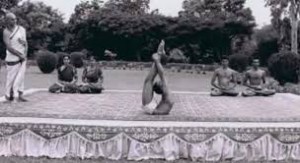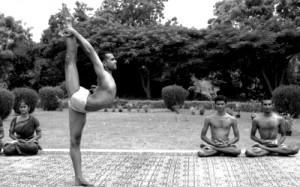 Breath of the Gods is a documentary by a German film maker (now available on Netflix) who sets out to discover the origins of modern yoga postures by exploring the life of Tirumalai Krishnamacharya, teacher to the big three in modern hatha yoga; Pattabhi Jois of the Ashtanga Vinyasa line, TKV Desikachar, a son of Krishnamacharya and linked to Viniyoga, and B.K. S. Iyengar, brother-in-law of Krishnamacharya. It is quite amazing to see the three totally different and amazingly popular approaches to teaching the postures that grew out of Krishnamacharya’s yoga school.
Breath of the Gods is a documentary by a German film maker (now available on Netflix) who sets out to discover the origins of modern yoga postures by exploring the life of Tirumalai Krishnamacharya, teacher to the big three in modern hatha yoga; Pattabhi Jois of the Ashtanga Vinyasa line, TKV Desikachar, a son of Krishnamacharya and linked to Viniyoga, and B.K. S. Iyengar, brother-in-law of Krishnamacharya. It is quite amazing to see the three totally different and amazingly popular approaches to teaching the postures that grew out of Krishnamacharya’s yoga school.
Pattabhi is down to his last few months and dies during the filming, but we do see him reminiscing, discussing yoga, and instructing a group class to get a feel for his presence. Unfortunately, Desikachar, whose style is probably the closest to that of Krishnamacharya in his later years does not appear at all, possibly because of illness; but the youngest of Krishnamacharya’s sons, T.K. Shribhashym, and two of his daughters, Alamelu and Shubha are wonderful at helping articulate their father’s teaching methods and how they evolved. Shribhashym has a big role in the film and helps us realize his father’s impressive dedication to reviving hatha yoga in India, in spite of the total lack of respect accredited to ‘yogi’s.
during the filming, but we do see him reminiscing, discussing yoga, and instructing a group class to get a feel for his presence. Unfortunately, Desikachar, whose style is probably the closest to that of Krishnamacharya in his later years does not appear at all, possibly because of illness; but the youngest of Krishnamacharya’s sons, T.K. Shribhashym, and two of his daughters, Alamelu and Shubha are wonderful at helping articulate their father’s teaching methods and how they evolved. Shribhashym has a big role in the film and helps us realize his father’s impressive dedication to reviving hatha yoga in India, in spite of the total lack of respect accredited to ‘yogi’s.
There are several archival segments of Krishnamacharya, Iyengar, Alamelu and Shubha,  some familiar to those who have seen the 1938 practice that has been around a while, and some new. There are also some ‘reconstructions’, modern enactments of actors pretending to be Krishnamacharya and his students, but these actors are ‘eye opening’ in the ease in which
some familiar to those who have seen the 1938 practice that has been around a while, and some new. There are also some ‘reconstructions’, modern enactments of actors pretending to be Krishnamacharya and his students, but these actors are ‘eye opening’ in the ease in which  they perform some very advanced yoga poses. Try this padangustha dhanurasana on for size! Or this natarajasana!
they perform some very advanced yoga poses. Try this padangustha dhanurasana on for size! Or this natarajasana!
Iyengar is, of course, a scene stealer and gets lots of face time. He talks about his relationship with Krishnamacharya, (no new ground here), and how he learned to teach himself the poses.  You also see him practicing amidst the chaos of the Pune studio, and the some of the best parts are when we watch him teach. Follow as he instructs his granddaughter in a twist to differentiate between the object (the outer aspect) and the subject (inner aspect) of the pose. In urdhva dhanurasana, watch him help her find the height in the pose from the DFL (deep front line) by using the ankles. From the other end, extend through the armpits, do not force the wrists. In teaching the director sirsasana, he show how to ground the wrists and lift through the twin pillars of the side bodies activated by the leg action. It was almost painful to watch, knowing he is no longer here.
You also see him practicing amidst the chaos of the Pune studio, and the some of the best parts are when we watch him teach. Follow as he instructs his granddaughter in a twist to differentiate between the object (the outer aspect) and the subject (inner aspect) of the pose. In urdhva dhanurasana, watch him help her find the height in the pose from the DFL (deep front line) by using the ankles. From the other end, extend through the armpits, do not force the wrists. In teaching the director sirsasana, he show how to ground the wrists and lift through the twin pillars of the side bodies activated by the leg action. It was almost painful to watch, knowing he is no longer here.
If you have more than a passing interest in the modern yoga scene, this is definitely worth a look.

